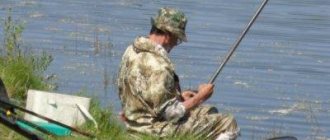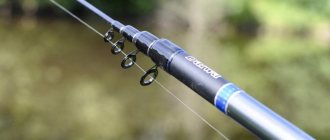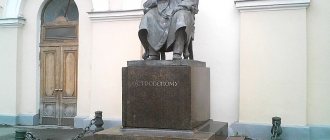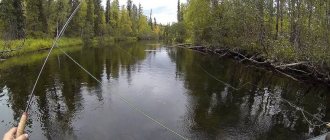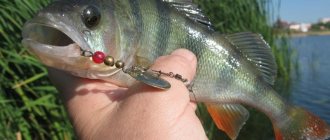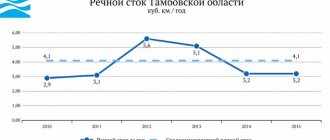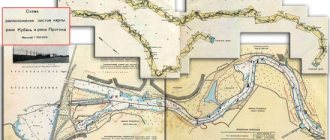Fishing within the city
St. Petersburg and the Leningrad region are rich in good fishing spots.
Among them are the ponds on Srednyaya Rogatka. They are located within the city limits - in the Moskovsky district of St. Petersburg. The quarry is located within St. Petersburg, near the street. Sedova and Sortirovochnaya railway stations. This reservoir owes its appearance to the porcelain factory founded by Empress Elizabeth. In pre-revolutionary times, sand mining was organized near the village of Shchemilovka, carried out on a significant scale.
Fishing on the Neva is very diverse in terms of the fact that you can catch any fish that is found in the Neva. There were cases when even a shark was caught in the Neva. You don’t even need to talk about the fact that within the city limits you can catch eel, lamprey, salmon, sturgeon, asp or trout; in the Neva it’s possible to catch everything!
Fishing near the Central Park of Culture and Culture is popular, but it has its own characteristics that have long been known to experienced fishermen. In mid-summer, the main problem for fishermen appears on the river - a lot of grass grows near the banks, which makes it impossible to fish in the coastal zone (about 8–9 m)
The Okhta River is a legendary place that is on the lips of every Russian. This is the largest of the right tributaries of the Neva, the mouth of which is located next to Petrozavod. The length of the Okhta is almost 100 km, the width varies in different places from 10 to 50 m, while the river has almost no places where it can overflow widely.
Fishing on the Suzdal lakes is carried out almost all year round. During winter fishing, white bream and bream bite. Since these fish love great depths, it is better to catch them in holes in the center of the lake. Fish also respond well to bait, especially if it contains bloodworms. Also in winter, perch and roach are caught on the Suzdal lakes
The fish in the Lakhtinsky Razliv are very large, but catching them is not always easy. Pike is caught using traditional methods - using spoons, twisters, vibrating tails and spinners. Along with pike, you can catch good pike perch or pike perch. In general, the Lakhtinsky Razliv contains almost all the fish that are found in the Gulf of Finland
Fishing on the Black River
Last Saturday I decided to go exploring small rivers in the Leningrad region. The original plans included a detour around two rivers and one small lake in the forest. But having arrived at the first place, on the Black River, he remained there all morning.
Like last time, I didn’t find anyone willing to go fishing with me, so I decided to go more for exploration than fishing. I didn’t buy worms or maggots, I just took a spinning rod and left the house at 6.30 to arrive at the place by dawn. I didn’t choose the place by chance; many years ago I was here with a float rod and caught perch.
There are no entrances to the river itself, so I left the car right on the highway, on the side of the road, and then walked through the forest. The last time I was here was ten years ago, so I didn’t immediately find the path to the river. At first I came across a small puddle, which I took for a river and was afraid that it had become so shallow. This small reservoir was covered with thin ice, and I thought it would be impossible to fish.
Turning on the navigator on my phone, I realized that I had not reached the river for another fifty meters. It’s not easy to walk fifty meters through a forest overgrown with small bushes, but I still got to the river and realized that I had to go a little to the left, where there was quite a decent path to the same place. This meant that I was far from the only one who knew about this place.
The river looked very beautiful, all the trees and grass on the bank were covered with frost.
Lilies of the valley are beautiful not only when they bloom
There is a moderate current on the river itself, but when I looked at the surface of the water, it seemed that the river froze for a moment and was ready to be covered with ice. From the car I only took a spinning rod, one reel with cord and a small box with spinners and wobblers. I was the first to try the Finnish wobbler from JAKKI, which has been tested many times on such reservoirs.
And as it turned out, it was not in vain that literally on the third cast he was attacked by a pike about a kilogram in size. Because of the dark bottom, the water seemed not transparent, but it was not so, I could clearly see how the wobbler was moving in the water column and this helped to give it the necessary movements, playing with the tip of the spinning rod. And I also noticed a pike before the strike, which rose from somewhere in the depths and rushed after the wobbler; all I had to do was slow down the retrieve and hook it after it swallowed it.
Very interesting fishing and almost at the very beginning. It’s good that I put a leash, I didn’t really count on pike, but hoped to practice on perch.
Having calmed down after the first short fight, I looked around the area, realizing that I had to move, pike and perch do not travel in schools.
There was beauty and complete silence all around. Walking along the shore and calmly throwing a spinning rod is not so easy.
In addition to small and not so small trees growing all over the shore, the task of movement was complicated by beavers. These lovers of building dams have piled up so many trees that the forester would be rich if he could fine them for cutting down green spaces.
Beavers live in burrows (huts), the entrance to which is always under water for safety. Beavers are adapted to a semi-aquatic lifestyle. Slow-flowing rivers, quarry ponds and reservoirs that do not freeze to the bottom are chosen as places of residence. For beavers, the presence of trees and shrubs of soft deciduous trees along the banks of the reservoir is important. Beavers are excellent swimmers and divers, but on land they are clumsy. They have very good hearing, there is a version that by the sound of rushing water, they determine the destruction of the dam and sail to patch it up. Dams are built to maintain the water level in the area where they live, so that the entrance to the burrow is always under water.
Hearing danger, beavers dive under the water and strike the water with their tail, warning everyone else. Well, if danger is found on the shore, while (cutting down) another tree, then he rolls on his belly into the pond, thereby rolling out a path similar to a slide.
On flat banks, beavers specially dig channels through which they move building materials for platinum and food. Okay, I started talking about beavers and forgot about fishing.
Having made my way through the bushes to the river, ten meters from where the first pike was caught, I again sent the wobbler into the water. The wobbler did not fly as far as I expected, and the reason turned out to be that all the rings and the cord itself were covered with a thin layer of ice. Having walked another five meters to the next place, my cord finally froze into the tulip at the tip of the spinning rod. I had to warm it up with my hands. It’s a shame I didn’t take another spool of fishing line from the machine, it doesn’t absorb water as much as a cord, and everything would have been much simpler.
During the next retrieve, I notice how a pike of approximately the same size rushes and misses the wobbler. Having missed, she pretended that she was just swimming by, and without changing direction, she smoothly sank into the depths. I quickly pulled the wobbler out of the water and threw it back to the same place. The pike didn’t take long to wait and again rushed at the artificial fish. Under the influence of adrenaline, I sharply jerked the spinning rod and tore the wobbler out of my mouth, as if I specifically didn’t want to give it to her. This time the pike pricked itself on the sharp hooks and did not want to attack anymore, no matter how much I tried.
Without being particularly upset, I began to make my way further along the shore and explore the few clearings in the water, free from bushes and logs fallen by beavers. There was no further reaction to my wobbler.
Having exchanged the wobbler for a spinner and returning to the original point, I continued the examination in the other direction. Having also walked about two hundred meters, no bites were observed. And the perch that I expected to see did not show itself in any way. Having torn off a couple of spinners along with their leashes and got caught in the bushes, I lost hope of catching a pike, realizing that without a leash it would bite off my wobbler or spinner in no time.
It was already twelve, and I decided to return home. After sitting on the shore, drinking coffee from a thermos and admiring the nature, I began to slowly get ready. While I sat motionless, the local inhabitants slowly began to show themselves.
True, I never saw the beaver; they work mainly at night, and knowing about my presence, they certainly did not intend to crawl out of their homes.
At the end I will show a little video that I shot while wandering along the river. The experiment with mounting the camera on the head (on the cap) was not very successful, the angle was wrong and there were a lot of unnecessary movements.
Similar articles:
Please rate the article
( 15 ratings, average: 4.60 out of 5)
Geographical information
The length of the Black River is a little more than 8 km, its width reaches 20 m in the lower reaches. The depth of the river ranges from 1 meter to 3.
Before the start of large-scale urban development work in the Primorsky region in the 1980s, the Black River took its source from a vast swamp bordering Lake Dolgoye from the south. The basin of Lake Dolgoye, with an area of 5.7 km², was approximately half of the catchment area of the Black River. Its length in its natural state was approximately 6.5 km. Along this length, the Black River received numerous small watercourses and drainage ditches laid through marshy areas. The river basin was replete with springs and outlets of pressure groundwater.
Currently, the upper part of the Black River bed is either led into underground sewers or has become an element of underground drainage. In addition to the developed sites of several large stores, the Black River catchment has undergone (and continues to undergo) intensive construction work.
The development of the territory north of the Serafimovsky cemetery led to fundamental changes in the hydrographic network of this part of the Black River catchment, and until approximately 2009, several sections remained here in a quasi-natural state, including a fragment of the river bed adjacent to the territory of the O'Key hypermarket from the north. Currently, these sections of the Black River bed are filled up. The modern source is located at the intersection of Baikonurskaya Street and Bogatyrsky Avenue.
In its lower reaches, the Black River has retained the features formed by the second half of the 20th century and flows into the Bolshaya Nevka. The length of the preserved section of the Black River is about 4 km, that is, more than 60% of the total length of the river in its natural state. During low-water seasons, the river mouth section is backed up by the Bolshaya Nevka and at times turns into a narrow bay. The level regime of the Black River below the Chernorechensky Bridge (Torzhkovskaya Street) in the summer practically corresponds to the course of the levels of the Bolshaya Nevka.
The average long-term water level of the Black River in the lower reaches is 14 cm BS. The annual river flow rate at the mouth before 1988 was 100 l/s. The Black River has been assigned the second category of fishery water bodies.
In 2006, Roshydromet of the Russian Federation classified the river pollution class as 4A (5 maximum) with a tendency to stabilization. Main pollutants: BOD5 (O2), nitrite nitrogen, copper, manganese, zinc.
According to the State Water Register of Russia, the water management section of the Neva River, the river sub-basin of the Neva River and the rivers of the Lake Ladoga basin (without the Svir and Volkhov sub-basins, the Russian part of the basins) belong to the Baltic Basin District. Belongs to the river basin of the Neva River (including the river basins of Lake Onega and Lake Ladoga).
The finish of the vacation will be fishing outside Zelenogorsk
After Turkey, my soul asked to go to my native river to sip on pike and perch. The very next day after our arrival, we began preparing for our trip to Tom! Vitalka took a couple of days off and we decided to rush towards Zelenogorsk, try to make our way along the road towards Red Lake and go fishing.
On the last day before flying to Turkey on vacation, I successfully passed the exam for the right to operate motor boats! And with a clear conscience he went on vacation to the Mediterranean Sea. After arriving, the first thing I did was run to GIMS to get my license and go fishing with my boat kit. The Flagman 350 boat and the 9.8 SiaPro motor were purchased in the spring and had not yet been on the water. The spawning ban and closed navigation until May 25 prevented me from testing my kit. My kit is not subject to registration, and a license is not needed, but with a license it’s easier, and in our family there is another kit with an 18 horsepower engine, so the license is not at all superfluous.
We decided to go fishing on Thursday afternoon. It would have been possible in the morning, but my friend Vitalka also took his boat license in the morning! In the second hour he called and said that he had successfully passed all the exams and was going to take me and my belongings to the garage! There were a lot of things: a boat; motor; tackle. It’s good that we are traveling together on Vitalkina’s “BUKHANKA” - there is a lot of space, and consider it an apartment on wheels.
Things are collected and we hit the road. The road ahead is almost 100 km. Moreover, at an intersection with bad sections - at the very end of the road. The road flew by quickly, there was more than enough to talk about, especially since we had not seen each other for almost two weeks.
I suggest watching a short video about the further path to the parking lot. At the end, a more than extreme path awaited us. On the way, we even managed to dent the Uzik’s wings a little. LET'S LOOK!!!
We arrived at six o'clock and began setting up the camp, preparing food and collecting gear and a boat. We decided to go fishing the next day in the morning. The evening was a great success! Signature pea soup with smoked meats, a bottle of homemade cranberry liqueur and conversations until dark around the fire. The only annoying thing was the RAZING number of mosquitoes - damn them! Repellents and spirals did not help at all; near our place there were two lakes and a hefty “Kolashnoe swamp”. The soup was impossible to eat due to the fact that mosquitoes were constantly swooping into the plates. By installing a mosquito coil in the UAZ, we killed more than one hundred blood-sucking mosquitoes.
I wake up at 4:00, dawn is breaking outside! With difficulty getting up, I begin to get ready to go fishing. I lower the boat, put on the motor, and put away the necessary fishing gear. He started the engine, let it roar, and drove upstream. There is a lot of water in Tom, so there are no problems with movement yet, I calmly pass through the riffles and go upstream.
My kit is Flagman 350 and Sia Pro 9.8 engine.
License to operate a motor boat.
After walking about 5-6 km. I reached the confluence of the stream from Red Lake into Tom, where I decided to start my fishing. Having stabbed, I begin to methodically fish a promising place with a fan. The emphasis was on wobblers, and only then I switched to a retractable leash. Not a single bite! I change place - the same thing, I decide to go even higher. Along the way I admire the beauty of our river! The motor quite briskly carries my boat upstream. But even there I never earned a single bite. 3 hours of fishing had already passed and I was really hungry, I decided to return to camp to have a snack.
Fog rises across Tydon.
The confluence of the stream flowing from Lake Krasnoye.
After a snack, I fall back into the boat and set off downstream. There is still a lot of water in the Tom, so promising places on the river are hard to read. The water has flooded the nearby bushes and the pike is probably holding on in the net.
While rafting downstream, I scan the shoreline to no avail. I find my favorite quiet spot behind the islands and drop anchor.
The raft flooded along the banks is one of the best shelters in high water, it’s a pity that it’s practically impossible to get fish from there.
On the left is my favorite bay in Zelenogorsk.
At first I relied on light wobblers and only then began to assemble a microjig rod. Having tied a fluorocarbon leash to the braid (with a counter knot), I installed a collapsible Cheburashka of 1.5 g. Having put a Fat Booty 1.6″ 40mm Ike worm on an open hook, I began to make the first casts to the border of the current and calm water. Already on the first retrieve I felt KNOCK-KNOCK - short, clear strikes on bites made it clear that I couldn’t delay hooking. I make a hook and at the other end someone resists, but rather weakly. Imagine my surprise when I pulled the troublemaker out of the water. This is Ruff!!! I've never had anything like this before!!!
The percentage of postings sold was approximately 1/2; from time to time, a small perch was pecked along with the ruff. There was no goal of bringing the fish home, so regardless of size, all the fish were released into their native depths. There were clouds and even small clouds running across the sky, but there was still a lot of sun and I even managed to sunbathe. Thank God, there were no midges or mosquitoes on the water.
The clouds were slowly starting to thicken!
Cool cloud!!! Looks like a dog.
Silicone “Leech” from Ukrainian craftsmen.
The ruff and perch were biting regularly for four hours. There was time to test different silicones and just enjoy the process.
Also silicone from Ukraine. Yura sent me several models to try out - they have very interesting models.
I’ll tell you a little about the tactics of catching ruff. During the fishing, one peculiarity was noticed: the ruffe pecked at a large separation from the bottom, or when moving into the water column. If the bait was carried out in the bottom layer, then most often the object of fishing was perch. Sometimes, on purpose, I did not let the bait fall to the very bottom and began to perform micro-oscillations with the rod, trying to make the bait play in one place. The perch bit on almost the same fishing line only in the bottom layer. In general, microjig fishing in river conditions turned out to be very interesting. Not only have I never caught a ruff on the MJ, but I also periodically began to come across Sorozhki, which also couldn’t help but make me happy. The fishing was already a success, we should have gone straight here in the morning - we wasted so much time in vain looking for fish.
Fibri Teil from Aiko 1.6″ showed himself perfectly on this fishing trip - a good replacement for my leader Ribet Vorm.
Nano-minnow from Crazy Fish.
After fishing almost until lunchtime, I went to camp.
Vitalka, loitering along the shore, didn’t catch anything and therefore was waiting for me to go with me in the evening to a quiet place, where I had a great catch. Upon arrival, after sipping some soup, we decided to test the Vitalkin motor on my boat. His miracle of Soviet motor engineering “Veterok 8l. With." didn’t want to work at all, he’s been rehearsing it for a year now, not without success, of course. Vitalka’s hands grow from where they should, so it’s only a matter of time. We install the engine and start it half a turn!!! Even I can’t start like that when it’s cold, but here it’s Veterok. With the new carburetor the engine started running like clockwork. While we were installing the engine it started to rain. The warm summer rain was a delight after the hot morning. We hid things that might get wet and continued testing on the water.
While Vitalka was boating, I decided to check out a nook with a snag that was not far from the camp. On the second cast, I felt the perch at the other end of the line shaking its head in the hope of freeing itself. Well, no, probably the biggest one today. Although the trophy is not great, it is dear to the fisherman’s heart. After making a couple more casts, I got another smaller striper.
View from our camp! A magnificent place, the eye simply rests when admiring the local beauty.In the evening the bite was much worse, but we were not left without a catch. Vitalka fished with spinners from the shore, and I ironed my calm with a microjig.
Aiko Furiya shot in acid in low light conditions (twilight).The next morning, without hesitation, we immediately went to the old points. Everything was repeated like a carbon copy - perch and ruff were pecked at the point just like yesterday. Vitalka wandered along the shore, looking at promising places with a turntable. Then, having caught nothing, he called me to his place to change the location and together break through a couple of interesting points.
Having picked up Vitalka, we changed the fishing point. Along the shore and the flooded Ivnik there was a small area of water with a small current and simply an incredible amount of fry. We anchored and started fishing. And then it flooded - dace (my first dace on a spinning rod), sorozhka, perch and all of a large size. It’s a shame the bite didn’t last long and we had to look further for fish.
Elchik.
Track.
Vitalka took a good okushka for mikruhu.
Having found an interesting area, we decided to fish for a couple more hours and head to camp at 10 o’clock. The bite started almost immediately and the perch here was larger than in other places.
Vitalka's dog Chacey was tired of our fishing, she whined and asked to go to camp. Let him get used to our trips.
Christmas tree on a turntable.
At 11 o'clock we sailed and started packing. Having calmly collected everything, we said “goodbye” to our place on the Tom River just above Zelenogorsk and set off on the difficult journey home.
The path home was indeed not easy; in one of the bad places we still planted our Loaf, even despite the installed chains. Okay, what can you do, unwind the cables, winches, take out the High Jack jack and chainsaw. We begin an operation to rescue the UAZ from captivity in the swamp. The UAZ rested not only on the bridges, but also partially on the body, so even with a 5-ton hand winch we could not move it. Having lifted both sides of the BOLIVAR in turn, we placed sawed-off logs under the wheels, and only after that did it go - slowly, but it went.
That's all our adventures! I consider this fishing an excellent FINISH for my summer vacation! See you all again, soon there will be a report on fishing in the treasured places on the Tom in the area of the Azhendarovo-Bungaraps channel.
Bridges and crossings
There are ten bridges across the Black River, six have names. The complete list of bridges looks like this: a reinforced concrete automobile-pedestrian bridge at the source of the river, on Bogatyrsky Prospekt, a pedestrian metal bridge in the alignment of Aerodromnaya Street, a pedestrian metal bridge near the corner of Polevaya Sabirovskaya and Zausadebnaya streets, a railway bridge near the exit to the river on Academician Shimansky Street ( actually two bridges - an old bridge with dismantled railway tracks and a new bridge along the main route of the Sestroretskaya railway line), Karelsky Bridge (a new bridge built in 2010-2011, put into operation in 2011), Kolomyazhsky Bridge (replaced by the Kolomyazhsky overpass), Lanskoy Bridge, Chernorechensky Bridge, pedestrian Stroganovsky Bridge, Golovinsky Bridge.
